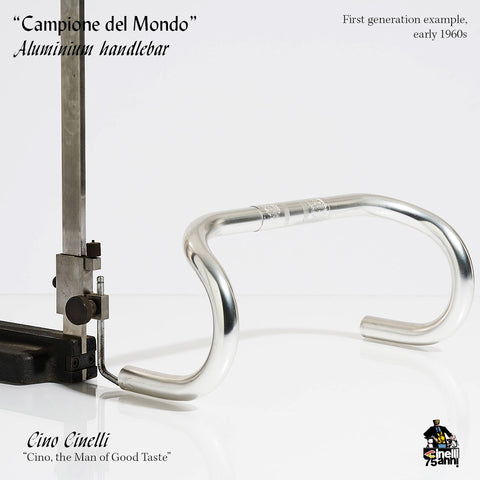chapter 3: cino the man of good taste

What perhaps distinguishes Cino Cinelli most from other luminaries of the golden age of modern Italian cycling design is his particularly refined good taste and his desire to integrate aesthetic considerations in his design even only for the sake of beauty, very unusual in such a rational man!
Cino’s most famous and iconic designs in fact go well beyond the dominant philosophy of his peers that “form follows function”.
And it is this ability to balance both “form follows function” and “beauty for beauty’s seek” within the same object that we still practice today and continues to differentiate us from the rest of the cycling world.
 |
 |
It is said that Cino - son of small landowners who was raised in rural outskirts of Florence – first began to develop his concept of taste when working for a small publisher as a teenager and, later, frequenting the upper-middle class environment of his Swiss future wife’s family.
Whatever the genesis of Cino’s good taste (and confidence in exercising it) perhaps the finest, most iconic examples of its expression are to be found in the paint of the Supercorsa, the 1R stem and the “milky” anodization of his aluminium components, which in itself became a globally recognized signature of quality.
 |
 |
Supercorsa paint: today it is a little difficult to contextualize quite how different a 1950s Supercorsa looked to any other Italian racing bicycle of the period. Up until the 1960s it was common for racing bicycles to be painted in matte pastel shades, like the famous Celeste Bianchi bikes. But from the early 1950s onwards Cino, eager for the Supercorsa – of which he desired to maintain a limited production in order now to be seen as a competitor to brands to whom he supplied tubes (as Columbus distributor), bars, stems and saddles – to be understood as a luxury bicycle, pioneered the use of metallic paint. His metallic paint, available in the classic silver, his own personal favourite “dusty rose” and champagne, was sourced directly from the Alfa Romeo factory on the outskirts of Milan. Together with meticulous attention to detail in the decals and badges, this paint gave the Supercorsa a unique, luxurious, allure.
 |
 |
1R stem: 13 years after having revolutionized the cycling world (and his own business) with the introduction of his first aluminium stem, the 1A, in 1960, in 1973 Cino presented the world with the 1R, the world’s most beautiful quill stem (and perhaps of any kind…). Beyond its breathtaking elegance the stem predates many of the most important trends in modern cycling through its minimalist design and absence of visible bolts.
 |
 |
Aluminium finish: possessed with a strong streak of conservatism, Cino Cinelli was late to the world of aluminium bicycle components. By the late 1950s – because of this recalcitrance, linked to his doubts regarding aluminium’s safety – Cino was in fact at risk of losing his marketing-leading position as a handlebar and stem manufacturer to new upstarts. When, in 1960, he finally committed to presenting his first series of aluminium components it was very much on his own terms, with distinctly oversized proportions (safety first) and a unique “milky” finish which gave the components an appearance radically different from Cinelli’s competitors (who simulated the look of steel with their aluminium parts).
Comprised of three phases that worked cumulatively, layer upon layer, to create a final result that was hard to imitate, the process is a distillation of Cino’s aesthetic philosophy. The first phase was a hand-guided high polish in which each piece, be it stem or handlebar, was caked with a cleaning agent and polished with discs of cloth that rotated at extremely high speeds until a mirror finish was achieved. This manually intensive but reliable process was preferred to more economical solutions available for aluminium, such as electro-polishing, which easily obtained a superficial coat of high polish but could not guarantee a consistent and symmetrical finish. The second phase was that of anodization, for which Cino chose a discreet, milky finish, which toned down the shine of each part. This was a particularly bold and sophisticated aesthetic decision, given that in doing so Cinelli was declining to exalt the extremely costly process of manual shining to which the pieces had already been subject. In the third and last phase, this discreet feel was fully realized with a sealing bath, which, in hardening the anodization in its particular way, conferred to the pieces a distinctive solid opacity—to say nothing of superior durability.





















